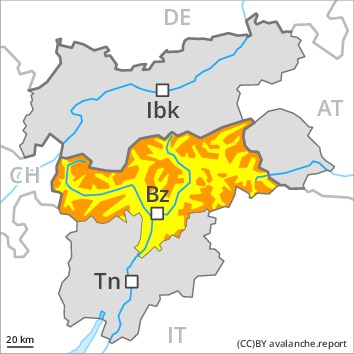
Danger level
 | 2000m
|
Avalanche Problem
 | | Wind-drifted snow |
|  | |  |
 | | Persistent weak layer |
|  | |  |
 | | Gliding snow |
|  | |  |

Fresh wind slabs represent the main danger. At elevated altitudes a considerable avalanche danger will still be encountered.
The fresh wind slabs can be released easily. or in isolated cases naturally, in all aspects above approximately 2000 m. The number and size of avalanche prone locations will increase with altitude. Avalanches can also penetrate deep layers and reach dangerously large size. Weak layers in the old snowpack can still be released in some places by individual winter sport participants in particular in areas where the snow cover is rather shallow.
A latent danger of gliding avalanches exists. Areas with glide cracks are to be avoided as far as possible.
Snowpack
dp.6: cold, loose snow and wind
dp.2: gliding snow
As a consequence of a moderate to strong northerly wind, clearly visible wind slabs formed, especially adjacent to ridgelines and in gullies and bowls above the tree line. The various wind slabs have bonded poorly together.
Faceted weak layers exist in the centre of the snowpack in particular above the tree line. This applies in all aspects.
Towards its base, the snowpack is moist and its surface has a melt-freeze crust, in particular at low and intermediate altitudes.
Tendency
The weather will be cold. As a consequence of low temperatures and the occasionally strong wind, the snowpack can not consolidate during the next few days. Fresh wind slabs require caution. In addition a latent danger of gliding avalanches exists.











